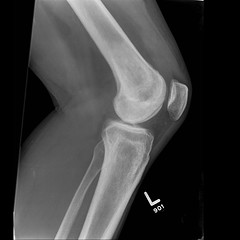You probably have experience with other wavelengths of light, but you might not have realized it. If you've broken a bone, or gotten an X-ray at the dentist, then you have experience with X-ray light (which is a little different than the “X-ray” your doctor shows you). Have you seen or heard of “night vision goggles”? These work by picking up infrared light.
Let's look at infrared and X-ray a little closer.
How different would the world look if we could see infrared, or IR light? Well, for one thing, we would be able to see our hand in front of our face in the dark! Our bodies actually emit IR light, which we experience as heat.
If we could see in the IR, everything that gives off heat would suddenly be apparent to us, even if there were no visible light! Since our eyes cannot see in the IR, something like night vision (or infrared) goggles can be used to see differences in temperature and to assign different brightnesses or false colors to the different temperatures or energies of IR light. This provides a picture that our eyes can interpret.
If we looked at animals with infrared goggles, we would see something similar to the images below. The image is color-coded to show differences in temperature. Notice that the puppy's nose is the coldest part of his body, so is shown in cooler colors, while his eyes are the warmest part, shown in reds. This shows how infrared images show heat energy and its distribution.
Images of a seal, a pony, a hound puppy, and a pair of turtles in infrared light.
* Images from the Infrared Zoo through the Infrared Processing and Analysis Center at Caltech.

What about X-rays? How do they work? Well, if we could see only X-rays, we could see things that either emit X-rays or halt their transmission. Our eyes would be like the X-ray film used in hospitals. When you get an X-ray taken at the hospital, X-ray sensitive film is put on one side of your body, and X-rays are shot through you. Because your bones are dense and absorb more X-rays then your skin does, dark silhouettes of your bones are left on the X-ray film while your skin appears transparent.
When the Sun shines on us at a certain angle, our shadow is projected onto the ground. Similarly, when X-ray light shines on us, it goes through our skin, but allows shadows of our bones to be projected onto and captured by film. To the right is the first X-ray image ever taken. Wilhelm Conrad Roentgen, who discovered X-rays in 1895, took this X-ray of his wife's hand. The shadows of her finger bones and wedding ring are all visible.
The electromagnetic spectrum
-
Images, spectra, and light curves